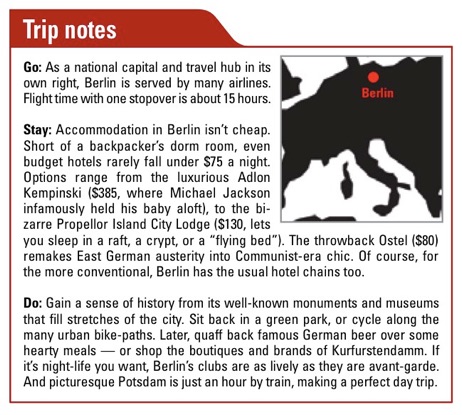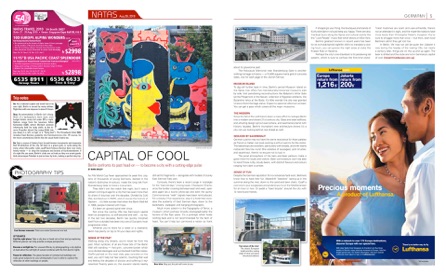T R A V E L S

BERLIN: Germany's Capital of Cool
As FIFA World Cup fever approached its peak last July, tens of thousands of young Germans, decked in the nation’s distinctive tri-colours, made the long trek from Brandenburg Gate to Victory monument.
They didn’t win the match that night, but it was a jubilant coming-of-age for a city that has seen more than its share of traumas over the decades. Divided by Cold War, bombed-out in WWII, and of course the horrors of Naziism… it’s little wonder that when the Berlin wall fell in 1989, people hollered with hope. It’s been an upward spiral ever since.
Not since the roaring 1920s has Germany’s capital been so prosperous, so self-assured and well… so hip. In the last two decades, Berlin has quickly morphed itself from a divided has-been into one of Europe’s most progressive cities.
Whether you’re there for a week or a weekend, Berlin has plenty on tap to fill your days and nights.
Sense of the Past
Walking along city streets, you’re never far from the past. Most symbolic of all are those bits of the Berlin still standing - that grim, concrete border which once divided ideologies and symbolized Cold War states. Graffiti painted on the west side, grey concrete on the east, you can’t help but feel solemn, touching that wall and feeling the decades of division and suffering it represented. Twenty years on, the souvenir stands nearby still sell its fragments – alongside with models of clunky East German Trabi cars.
Curiously, there’s been a recent surge in nostalgia for the ‘bad old days’ among locals. Checkpoint Charlie (once the border crossing between east and west) operates again (as a tourist photo-op) and even the quirky communist-era ‘walk’ signals were reintroduced. For a kitschy if fun experience, stay in a hotel that recreates the austerity of East German days, down to the bedsheets, wallpaper and hanging photographs.
Much more solemn is the Topography of Terror nearby, a museum which portrays (mostly photographically) the horrors of the Nazi years. It’s a portrayal which appears holds back nothing and is not recommended for the feint of heart. You can’t help but commend a nation so frank about its gruesome past.
The Holocaust Memorial near Brandenburg gate is another striking homage to history - a 19,000 m2 grid of concrete slabs, one for each page of the Jewish Talmud.
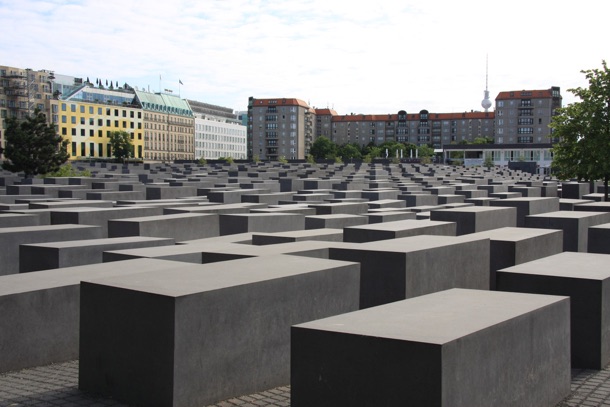
The Holocaust Memorial, near Brandenburg Gate with its stark if memorable geometries.
Museum Island
To dig further back, Berlin’s central Museum Island on the Spree river offers five internationally renowned museums side by side. Visit painstaking reconstructions like Babylon’s Ishtar Gate (at the Pergamon) or the Neues’ collection of Egyptian artifacts, the Byzantine relics at the Bode. It’s little wonder the site was granted UNESCO world heritage status. Expect an afternoon at least. You can get a pass which covers all the major museums.
The Modern
Since the fall of the wall there’s been a mass effort to reshape Berlin into a modern and vibrant 21st century city. Glass and steel edifices, and amazing design sprout everywhere, and seamlessly blend with historic facades. Berlin’s triumphant new architecture shows it’s a city not just looking behind, but ahead as well.
Seduced by Sauerdraut
German cuisine may not have the same resonance for Asian palates as French or Italian, but local cooking is still a must-try for the visitor. The bakeshops are excellent, particularly with breads, and with hearty restaurant fare like wurst (the varieties of sausages), pork knuckle, and sauerkraut, there’s no excuse not to tuck in.
The jovial atmosphere of the bars and beer parlours make a good mixer for locals and visitors. Beer connoisseurs won’t be able to resist those nutty, cloudy beers distinct flavours and colours ranging from dark to amber.
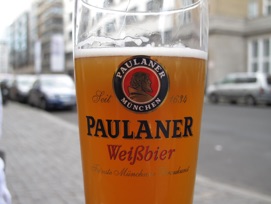
Plenty more where this came from in Germany’s capital.
Sense of Fun
Despite the German reputation for no-nonsense hard work, Berliners know how to have their fun. Makeshift ‘beaches’ spring up in the summer along the river, down to the sand and lawnchairs. Quaff a cool one in your sunglasses and pretend you’re on the Mediterranean for an hour or two. Or pedal a ‘beer bicycle’ around the city with 12 new-found friends.
If shopping’s your thing, the boutiques and brands of Kürfurstendamm should keep you happy. There are also riverboat tours along the Spree and cultural events like the ‘Love Parade’ music fest which draws a million fans.
Berlin’s greatest renown in recent years has been for its no-holds-barred nightlife. With: no mandatory closing hours, so you can groove the night away at clubs like Knaack Klub or Havanna.
Perhaps the city’s one drawback is its perplexing rail system, which is sure to confuse the first-time visitor. Ticket machines are scant and user-unfriendly, there’s not an attendant in sight, and the maze-like stations have more levels than Inception. You’re sure to struggle more than once - but then, even local Berliners admit they get lost too.
In Berlin, life may not yet be quite the ‘Cabaret’ it was during the heyday of the roaring 20s, but nearly a century later, things are on the up and up again. The beer is chilled and the clubs are hot in Germany’s capital of cool.
Willkommen, bienvenue, welcome!
This article article is currently available online here.
by Mark Malby
Friday, 25 February 2011

Twenty years on, jubilant hope still adorns remnants of the Berlin wall - photograph Mark Malby
Two views of the river - Berlin presents both a classical and an upgraded face - photos Mark Malby
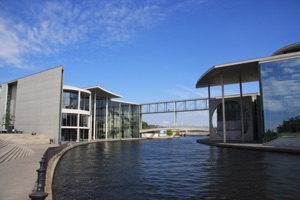
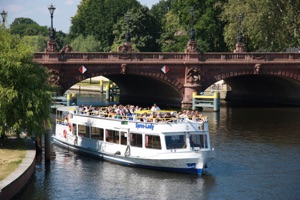
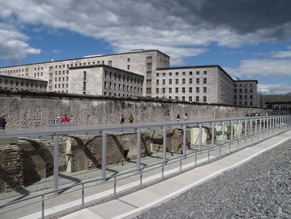
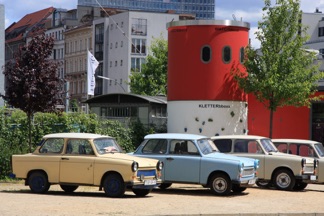
The past comes in the grim concrete of the Berlin Wall and Nazi bunkers (left) - or kitschy, colourful Trabi cars (right)
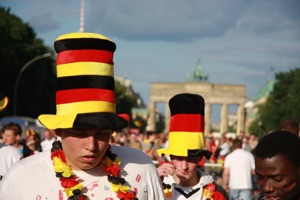
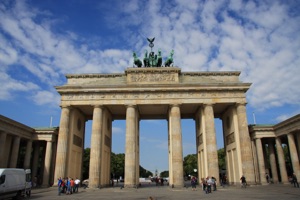
Football enthusiasts march during 2010‘s FIFA world cup (left) and Brandenburg Gate (right)
